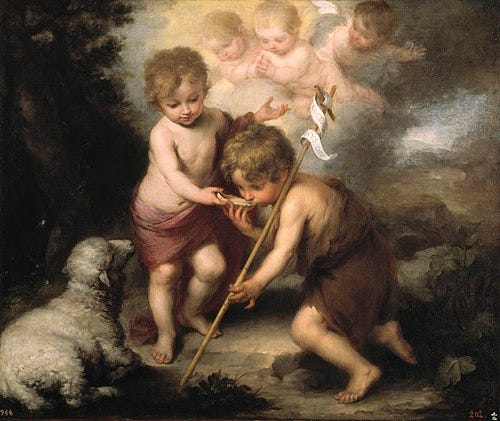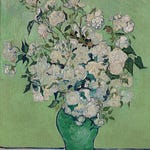It’s odd to think that so many of our nursery rhymes are still with us, even though most little children are now far away from the things they take for granted as part of ordinary life. “Four and twenty blackbirds baked in a pie”? Have any of our readers here ever had blackbird pie? Or “Jack and Jill went up the hill to fetch a pail of water”? I’d like to say I’ve drawn well-water from a bucket, but I can’t remember that I have — though I have gotten fresh ice cold water from a bubbling spring. And then there’s Mary skipping off to school one day, with her little lamb — our Word of the Week — following after her. Evidently, Mary did not have to wait for the traffic light to change on 155th Street in Queens, to get to P.S. 201. And yet for all our distance from such a creature, and please understand, I didn’t grow up on a farm, we still esteem that inoffensive little animal, the lamb, bleating and woolly and frisking in the field, before he or she grows up to be a sheep, getting down to the serious business of grazing all day long and leaving the frisks to the youngsters.
Where we lived when I was a boy, you didn’t often see lamb chops in the stores, much less legs of mutton, so that I remember my mother serving lamb to us only once, with green mint jelly. I liked it well enough, but nobody else did, but since then I’ve had lamb every long once-in-a-while, usually at an Indian or Greek restaurant. It doesn’t really taste like anything else, not that I know of anyhow, so I can understand if some people don’t enjoy it. Of course, in Scripture, the Passover lamb, which might also have been a kid goat, was eaten with bitter herbs and unleavened bread, its blood sprinkled on the lintel and the doorposts so that the angel of death would pass by. It was to be a solemn meal eaten by people in haste, marking their deliverance from bondage in Egypt, and foreshadowing their flight from the Pharaoh and his armies as they passed the waters of the Red Sea. But in general, the lamb figures prominently in the sacrificial meals of the ancient Hebrews. “Here are the wood and the fire,” says the boy Isaac to his father Abraham as they climb up Mount Moriah on that fearful morning, “but where is the lamb for a burnt offering?” “My son,” said Abraham, no doubt with a clutch in his throat, “God will provide himself a lamb for a burnt offering.” And God did just that. It was not to be Isaac. The true God does not demand human sacrifice. The reverse is true, though Abraham couldn’t have known it at that time: the Son of God will carry the wood up the mountain to sacrifice himself for man. That’s what John the Baptist means when he says, gesturing toward Jesus, “Behold the Lamb of God who takes away the sins of the world!” And I doubt very much that anybody within earshot of John understood that, either.
We look at a lamb, and we think of its meekness, its innocence. It’s a thorough reversal of expectations, when John the evangelist sees the Lamb of God enthroned. That’s because we tend to admire brute strength, political power, relentless ambition — can you imagine an ambitious lamb? I can’t. Or a lamb, baring its teeth? We call children lambs, because they too are innocent and beautiful, more beautiful by far than lambs, and I guess not quite as innocent. But wicked people like to adopt the outward guise, as wolves in lambskin. Says Chaucer’s character False Semblant, in his Romance of the Rose, if you’ll let me translate slightly, “Of Antichrist’s men am I, / Of whom Christ says quite openly, / They have a bit of holiness, / But live in just such wickedness. / On the outside, we’re lambs, you see, / Full of good and charity, / But inward, and this is no fable, / Like wolves devouring all we’re able.”
Now here’s a funny thing about the word lamb. In the passage I’ve tweaked above, Chaucer doesn’t say lambs but lambren, just as we don’t say childs but children. Let me explain. There were several ways to make plurals in Old English, depending on the gender of the noun and its declension. Almost all nouns in modern English went over to the most common way to pluralize masculine nouns, in -as, shortened to -es and -s. Modern German, though, kept four ways of making plurals, and one of them is in -er: so we have das Haus, the house, but die Häuser, the houses. The plural for lamb in early Old English was lambru, just as the plural for child was cildru (think of German Kinder, meaning children, as in Kindergarten). But eventually that way of making plurals faded, and so when people heard the Middle English word childer, it didn’t sound like more than one, so they added another plural sign to it, the -en by analogy with oxen, and sounding like the plural men and women. That’s how we ended up with the double plural children, which has stuck, and how Chaucer ended up with lambren, which didn’t. Brethren is another such plural on top of a plural, as foremost is a superlative on top of a superlative.
Here’s hoping that you enjoy a fine spring — or, for our friends in the Antipodes, a pleasant autumn — with neighborhood children outdoors at play, where they ought to be, lambs that they are!
Listen to this episode with a 7-day free trial
Subscribe to Word & Song by Anthony Esolen to listen to this post and get 7 days of free access to the full post archives.













